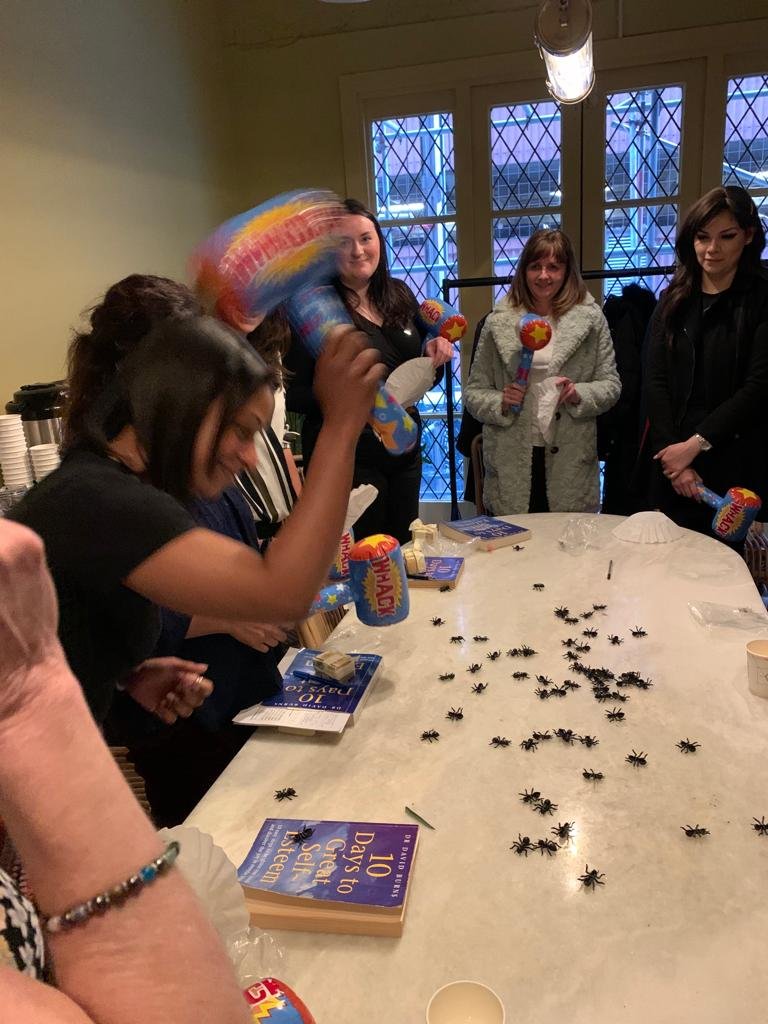Transforming Self-Esteem Abroad via Zoom
The 11-Weeks to Self-Esteem Support Group has expanded not only throughout the United States, but the program has touched various countries, including the United Kingdom and Switzerland. It was not long after The Counseling Center for Change’s owner, Dawn O’Meally sat down in an interview with Dr. David Burns and his podcast Feeling Good, when O’Meally wanted to expand the program’s horizons and expand the program outside of the United States—so she did.
Facilitating the program via Zoom during Covid-19, which many would agree to be the peak of the mental health crisis. Dawn began her networking and began her program in the UK and Switzerland, which proved to be so impactful for the UK group that Dawn set out to meet the associate facilitator and graduates from the course.
Continue reading to learn about Dawn’s experience to meet the group from the UK.
Where do I begin - I never imagined I would fly across the pond to England to celebrate one of my 11 Weeks to Self Esteem group graduation that I had previously only done in my office in Westminster, Maryland, for the past 22 years!
It was a fantastic experience to finally meet the women in person from the UK Manchester Women's Empowerment Group (EW) on April 9, 2022, who participated in my Zoom group psychoeducational program-11 Weeks to Self Esteem!
The group of women I met up with in the UK was started by Rokhsareh Vahid "Roxy." Roxy created the EW Group in June 2021 through MeetUp. It has grown to over 1200 women and recently became a non-profit organization. Roxy's passion is about "learning and helping women to live their best life, reach their highest potential through self-development resources, and where empowered women empower each other". Credit to Roxy for spearheading bringing women together and being a shining light to them, having risen above her own past traumas and now wanting to give back and help women empower each other.
Roxy learned about my program while searching for a self-esteem resource to bring to the women in her EW group as part of the self-development learning track she wanted to incorporate. She came across me via the podcast I had done with Dr. David Burns about my 11 Weeks to Self Esteem Program last year.
Our connection was instant the first time we spoke -her why's and my why's were in sync, and it was a perfect match! So I offered to help support her mission by providing my 11 Weeks to Self Esteem course to EW members via Zoom. So far, the course has been completed 2x by amazing women wanting to learn tools, strategies, and methods to defeat Depression, Anxiety, Stress, Perfectionism, Procrastination, Stinkin Thinkin, and so much more. Their outcomes have been measurable, mind-blowing, and life-changing, so I was super excited to FINALLY meet these incredible women, and their leader, in person!
The first group completed the online course in early December 2020, and I had planned to travel to the UK to celebrate with them in person, but the Covid restrictions became extreme, so alas, I had to cancel the planned trip. It was unbearable to do so, but I was determined to reschedule the trip and decided to make lemonade out of lemons. We decided we would celebrate with not just the first group but both groups together that had completed my 11 Weeks to Self Esteem Program. The stage was set by Roxy and Soraya (the Self Development Director) for my arrival.
I flew to England with my props, gifts, 10 Days to Self Esteem book, and bulletin board. Yes, a small bulletin board with a picture of an Ant Hill painted on it. It definitely drew some curiosity in the airport! FYI, ANT is an acronym for Automatic Negative Thoughts. With plastic blow-up hammers, toy ants, and large coffee filters to write to, we would kill some ANTS! Of course, they had no idea what I had in store for them. Still, I wanted to create an in-person experience that involved processing what they had learned from the course and how it impacted them and reinforcing the CBT skills via interactive activities. When I arrived and saw Roxy, it was such an emotional moment for us. We practically ran towards one another and held an indescribable embrace as we were so excited to finally meet each other in person. Likewise, meeting the women that had participated in my program in person lent itself to more hugs and genuine warmth and gratitude from them during the exchange. I could never have imagined such a moment.
I wish we could have recorded their testimonies regarding HOW the 11 Weeks to Self Esteem program changed their lives as we went around the table and each person shared. We captured a lot of photographs that tell some of the stories of the experience. Back to the ANTs...
1. Each participant was given a blow-up hammer, a toy ant, and a coffee filter. The toy ants were spread out on the table before them as well.
2. I had each person write down on the large industrial size coffee filter a negative thought that they have about themself (i.e., I will never be good enough) on the outside bottom of the coffee filter. On the inside, I asked them to write down a positive thought to counteract their negative thinking on the inside bottom of the coffee filter (i.e., I am enough. I have been working on self-improvement). Each person was allowed to share their negative thought followed by their positive thought ( i.e., the straightforward approach). Then, they were instructed to beat that negative thought (ANT) with their hammer while speaking it aloud and challenging it. The women REALLY got into hitting the ANTS with their hammers. Some of the toy ANTS went flying off the table. It was a Cathartic Experience beating those ANTS. After each person shared, the women collectively BEAT the ANTS and boy, did they go flying off the table!
3. Following our exhilarating experience with beating the ANTS, I had all of the women stand up and hold their fluffed-up coffee filters with the bottom side facing them. Altogether, they let them drop to the floor. Guess what happened? The coffee filter landed right side up, and they could see their positive thoughts on the inside now facing them. They had "righted" their negative thoughts through this activity. They understood. They got it! The hammer and toy ant was given to each person to use "if needed" in the future at home!
4. Next came the more solemn part of the evening activity-the distribution of framed certificates and report cards by Roxy and me. I asked the women from the first group that had already graduated to form a line and stand facing each other, holding a long-stemmed carnation overhead. The women receiving their certificates and report cards were processed to the front of the room where Roxy and I were standing to give them their certificates and report card under the flowers held above them by the group that had gone before them. I had explained to the first group of graduates in attendance that they were the "firsts," and with that came a responsibility to pay it forward to those who come after them. They understood and, without hesitation, participated in this part of the ceremony. I later explained to the new group of graduates that they could pay it forward and what they learned by giving their testimony of how the program impacted them and inspired others to take the course.
Distributing the certificates and report cards was quite emotional and joyful at the same time. Yes, more hugs were exchanged!
Oh, the ANT bulletin board-we ran out of time, and I didn't get to do that activity. Next time! I left it in Roxy's care as Self Esteem Groups are planned and on the horizon for EW, and I plan to return.
Following our ceremony, we had to adjourn as it was time for dinner at the excellent restaurant where we held the graduation. We had a wonderful meal together (yes, with some toasts!) followed by sharing the pictured beautiful and yummy cake made by one of the women in the group.
From the bottom of my heart, I am grateful to have had the opportunity to spend in-person time with the lovely Self Esteem graduates in the EW group. You guys inspire me to continue to offer my Self Esteem Program- my professional passion. The experience reminds me of a song that I think captured the moments we shared-These are the Days by 10,000 Maniacs.
Thank you, Roxy, Soraya, and the Manchester Empowered Women's Group, for hosting me and organizing the fantastic event!
Much love,
Dawn






















